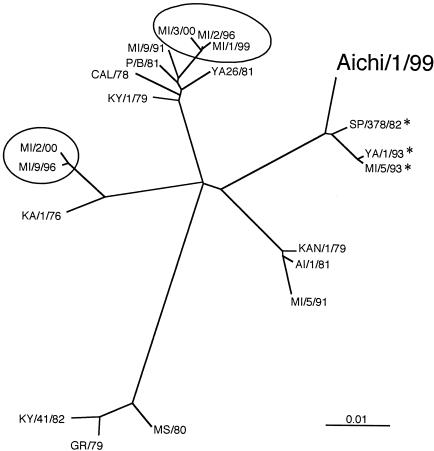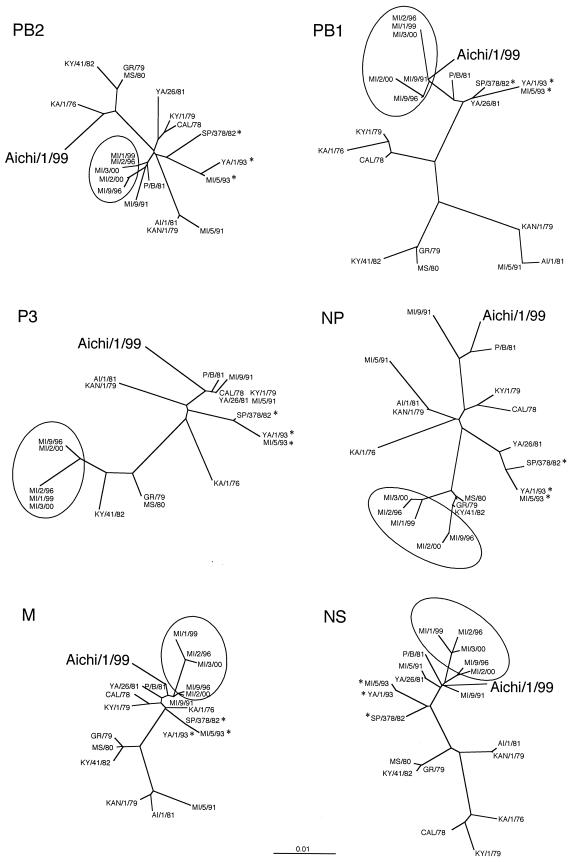Abstract
An influenza C virus was isolated from a Japanese traveler who had visited Malaysia in April 1999. Phylogenetic analysis indicated that the genome composition of this virus was distinct from that of any other strain isolated in Japan. The possibility that a genetically unique influenza C virus was introduced into Japan by a traveler is shown.
CASE REPORT
The patient was a 33-year-old male who had visited Malaysia from 1 to 7 April 1999. He presented with a fever of 38°C and a sore throat, which had started on 6 April, at Nagoya International Airport on 7 April. A gargle sample was taken at the quarantine station in the airport and transported to Aichi Prefectural Institute of Public Health. This sample was seeded in MDCK cells with trypsin (2.5 μg/ml) as previously described (17). Hemagglutination of the supernatant was found to be 1:16, 1:32, and less than 1:4 by chicken, turkey, and goose erythrocytes, respectively, and it was inhibited by chicken antiserum to C/Aichi/1/81 (1:512). Therefore, the patient was infected with an influenza C virus, and the isolate was named C/Aichi/1/99. To characterize the genetic relationships of this virus and the previous isolates, the nucleotide sequences of seven gene segments (PB2, PB1, P3, HE, NP, M, and NS genes) of C/Aichi/1/99 were determined by using methods described previously (11), and phylogenetic trees of individual genes were constructed by the neighbor-joining method with the Phylip program (version 3.573c). As shown in Fig. 1, the hemagglutinin-esterase (HE) gene of C/Aichi/1/99 was closely related to that of C/Sao Paulo/378/82 (SP/378/82) isolated in Brazil in 1982, whereas all of the internal genes of C/Aichi/1/99 were phylogenetically distinguishable from those of SP/378/82 (Fig. 2). Therefore, we conclude that C/Aichi/1/99 is a reassortant virus, having inherited the HE gene from an SP/378/82-like virus and the remaining genes from another virus not identified as yet.
FIG. 1.
Phylogenetic tree of influenza C virus HE genes (nucleotides [nt] 64 to 1989). Viruses in the SP/378/82-related lineage are marked by asterisks. Japanese strains isolated between 1996 and 2000 are circled. Abbreviations are as follows: MI, Miyagi (Japan); CAL, California (United States); KY, Kyoto (Japan); KAN, Kansas (United States); GR, Greece.
FIG. 2.
Phylogenetic trees for the PB2 (nt 52 to520), PB1 (nt 50 to 425), P3 (nt 49 to 420), NP (nt 71 to 670), M (nt 26 to 1,147), and NS (nt 28 to 889) genes. Viruses having HE genes of SP/378/82-related lineage are marked by asterisks. Japanese strains isolated between 1996 and 2000 are circled.
Influenza C virus is a common cause of upper respiratory tract illness (3), and seroepidemiological studies indicate that this virus is widely distributed throughout the world (1, 2, 7, 8, 14, 15). However, the virus has been isolated only occasionally; thus, the global surveillance of influenza C viruses is not carried out. Our long-term surveillance of children <15 years of age, which dated from 1988, revealed that outbreaks of influenza C virus occur during winter and early summer at intervals of 1 or 2 years (11, 12). The genome of influenza C virus consists of seven RNA segments, that is, PB2, PB1, P3, HE, NP, M, and NS gene segments (reviewed in reference 6). Phylogenetic analysis of the HE gene segment, which encodes a surface glycoprotein, showed that the five lineages represented by Kanagawa/1/76 (KA/1/76), Yamagata/26/81 (YA/26/81), Aichi/1/81 (AI/1/81), SP/378/82, and Mississippi/80 (MS/80) existed in Japan (10) and that two or three of these lineages cocirculated in a single community (5, 9, 13). Thus, mixed infection with influenza C virus belonging to different lineages is likely to occur in humans, resulting in the emergence of reassortant virus characterized by exchange of genome segments between two different strains (11, 16). Moreover, our surveillance revealed that reassortments among these viruses occur frequently and that newly emergent reassortant viruses have replaced the previously circulating viruses (12).
In April 1999, when C/Aichi/1/99 was isolated, no other influenza C virus was isolated in Japan, but four viruses were isolated from June to July as part of our surveillance work (12). The resulting phylogenetic analysis, however, confirmed that the HE gene of C/Aichi/1/99 is distinguishable from those of Japanese strains isolated between 1996 and 2000, which belonged to the YA/26/81- or KA/1/76-related lineages (Fig. 1). C/Aichi/1/99 was closely related to SP/378/82 in the HE gene tree. A strain with an HE gene from an SP/378/82-related lineage was first isolated in 1992 in Japan (10). Two strains of SP/378/82-related lineage isolated in 1993, Yamagata/1/93 (YA/1/93) and Miyagi/5/93 (MI/5/93), were genetically unique and phylogenetically indistinguishable from SP/378/82 in all seven genes (10). Therefore, it has been suggested that these viruses were introduced into Japan shortly before 1992. C/Aichi/1/99 is, however, clearly distinct from those strains of SP/378/82-related lineage isolated in 1993 with regard to the six internal gene segments (Fig. 2). The phylogenetic position of C/Aichi/1/99 seems to be related to those of C/pig/Beijing/115/81 (P/B/81) in the PB1, P3, NP, M, and NS gene trees. However, we could not identify any previous isolates with another parent from which C/Aichi/1/99 could have inherited the internal gene segments. To our regret, there is no report of the isolation of influenza C virus in Malaysia. However, it is strongly suggested that C/Aichi/1/99-like virus was circulating in Malaysia and was introduced into Japan, since the incubation period of type C influenza is 5 days or shorter (4).
We suspect that influenza C viruses, which have similar genome composition, are circulating worldwide, as are influenza A and B viruses, because most of the isolates in various areas of the world in the 1970s and 1980s were closely related to the contemporary Japanese viruses in all gene segments, as reported previously (13). Furthermore, future surveillance will try to determine if adult infections are the major means by which influenza C virus spreads. Hereafter, it is important to continue our surveillance work to ascertain whether a strain which is genetically similar to C/Aichi/1/99 can be isolated, and we hope that the global surveillance of influenza C virus may assist us in this work.
Nucleotide sequence accession numbers.
The nucleotide sequences determined in this study have been submitted to the DDBJ, EMBL, and GenBank databases and assigned the accession numbers AB182357 to AB182363.
REFERENCES
- 1.Homma, M., S. Ohyama, and S. Katagiri. 1982. Age distribution of the antibody to type C influenza virus. Microbiol. Immunol. 26:639-642. [DOI] [PubMed] [Google Scholar]
- 2.Jennings, R. 1968. Respiratory viruses in Jamaica: a virologic and serologic study. 3. Hemagglutination-inhibiting antibodies to type B and C influenza viruses in the sera of Jamaicans. Am. J. Epidemiol. 87:440-446. [DOI] [PubMed] [Google Scholar]
- 3.Katagiri, S., A. Ohizumi, and M. Homma. 1983. An outbreak of type C influenza in a children's home. J. Infect. Dis. 148:51-56. [DOI] [PubMed] [Google Scholar]
- 4.Katagiri, S., A. Ohizumi, S. Ohyama, and M. Homma. 1987. Follow-up study of type C influenza outbreak in a children's home. Microbiol. Immunol. 31:337-343. [DOI] [PubMed] [Google Scholar]
- 5.Kimura, H., C. Abiko, G. Peng, Y. Muraki, K. Sugawara, S. Hongo, F. Kitame, K. Mizuta, Y. Numazaki, H. Suzuki, and K. Nakamura. 1997. Interspecies transmission of influenza C virus between humans and pigs. Virus Res. 48:71-79. [DOI] [PubMed] [Google Scholar]
- 6.Lamb, R. A., and R. M. Krug. 2001. Orthomyxoviridae, p. 1487-1531. In D. M. Knipe, P. M. Howley, D. E. Griffin, R. A. Lamb, M. A. Martin, B. Roizman, and S. E. Strauss (ed.), Fields virology, 4th ed. Lippincott Williams & Wilkins, Philadelphia, Pa.
- 7.Manuguerra, J. C., C. Hannoun, and M. Aymard. 1992. Influenza C virus infection in France. J. Infect. 24:91-99. [DOI] [PubMed] [Google Scholar]
- 8.Manuguerra, J. C., C. Hannoun, M. C. Saenz, E. Villar, and J. A. Cabezas. 1994. Sero-epidemiological survey of influenza C virus infection in Spain. Eur. J. Epidemiol. 10:91-94. [DOI] [PubMed] [Google Scholar]
- 9.Matsuzaki, Y., Y. Muraki, K. Sugawara, S. Hongo, H. Nishimura, F. Kitame, N. Katsushima, Y. Numazaki, and K. Nakamura. 1994. Cocirculation of two distinct groups of influenza C virus in Yamagata City, Japan. Virology 202:796-802. [DOI] [PubMed] [Google Scholar]
- 10.Matsuzaki, Y., K. Mizuta, H. Kimura, K. Sugawara, E. Tsuchiya, H. Suzuki, S. Hongo, and K. Nakamura. 2000. Characterization of antigenically unique influenza C virus strains isolated in Yamagata and Sendai cities, Japan, during 1992-1993. J. Gen. Virol. 81:1447-1452. [DOI] [PubMed] [Google Scholar]
- 11.Matsuzaki, Y., K. Sugawara, K. Mizuta, E. Tsuchiya, Y. Muraki, S. Hongo, H. Suzuki, and K. Nakamura. 2002. Antigenic and genetic characterization of influenza C viruses which caused two outbreaks in Yamagata City, Japan, in 1996 and 1998. J. Clin. Microbiol. 40:422-429. [DOI] [PMC free article] [PubMed] [Google Scholar]
- 12.Matsuzaki, Y., K. Mizuta, K. Sugawara, E. Tsuchiya, Y. Muraki, S. Hongo, H. Suzuki, and H. Nishimura. 2003. Frequent reassortment among influenza C viruses. J. Virol. 77:871-881. [DOI] [PMC free article] [PubMed] [Google Scholar]
- 13.Matsuzaki, Y., S. Takao, S. Shimada, K. Mizuta, K. Sugawara, E. Takashita, Y. Muraki, S. Hongo, and H. Nishimura. 2004. Characterization of antigenically and genetically similar influenza C viruses isolated in Japan during the 1999-2000 season. Epidemiol. Infect. 132:709-720. [DOI] [PMC free article] [PubMed] [Google Scholar]
- 14.Motta, F. C., M. O. Luiz, and J. N. Couceiro. 2000. Serological analysis reveals circulation of influenza C viruses, Brazil. Rev. Saude Publica 34:204-205. [DOI] [PubMed] [Google Scholar]
- 15.Nishimura, H., K. Sugawara, F. Kitame, K. Nakamura, and H. Sasaki. 1987. Prevalence of the antibody to influenza C virus in a northern Luzon highland village, Philippines. Microbiol. Immunol. 31:1137-1143. [DOI] [PubMed] [Google Scholar]
- 16.Peng, G., S. Hongo, H. Kimura, Y. Muraki, K. Sugawara, F. Kitame, Y. Numazaki, H. Suzuki, and K. Nakamura. 1996. Frequent occurrence of genetic reassortment between influenza C virus strains in nature. J. Gen. Virol. 77:1489-1492. [DOI] [PubMed] [Google Scholar]
- 17.Sato, K., T. Morishita, E. Nobusawa, Y. Suzuki, Y. Miyazaki, Y. Fukui, S. Suzuki, and K. Nakajima. 2000. Surveillance of influenza viruses isolated from travellers at Nagoya International Airport. Epidemiol. Infect. 124:507-514. [DOI] [PMC free article] [PubMed] [Google Scholar]




